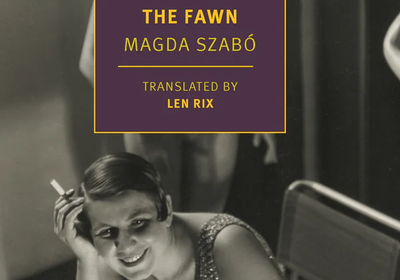-

-
The Discerning Mollusk's Guide to Arts & Ideas
-


The Fawn
Magda Szabó, translated by Len Rix
New York Review Books, March 2023
y her own account, the late Hungarian novelist Magda Szabó was a vengeful child. When a well-off relative remarked in her hearing that the little girl was plain and thin, so sickly she might not live to adulthood, young Magda was gripped by an intractable, primal hatred. When that same relative kindly offered to bring the child to her house in the country to receive the benefit of ample food and good air for a time, Szabó plotted for revenge and a swift return to her beloved parents. The child was warmly welcomed by her country relations, instructed to make herself at home but to stay clear of the drawing room filled with pristine new furniture. She sneaked away at the first opportunity, located the household scissors, and “slashed the covers of the six chairs and sofa to ribbons with infinite patience and application,” pulling out long trails of dark stuffing for even more dramatic effect. It’s only when she returned home, where her father can’t suppress a laugh at the intensity of his child’s grudges even as he’s forced to sell a cherished ring to compensate for the furniture massacre, that Magda registered the shame and consequences of her actions.
This scene of childish resentment from Szabó’s memoir Ókút (of which only a short excerpt has been published in English) could easily have come from one of her novels. Her most popular book Abigail, for instance, follows the trials of an adolescent girl named Gina prone to pride and headlong acts of private rebellion that, against the backdrop of the Second World War, harbor potentially disastrous consequences for others. An acute and compassionate psychologist of what she called her “terrible” women, Szabó deftly maintains the reader’s appreciation for the double edge of Gina’s passionate willfulness—its blinkered self-regard and its vital courage—as the heroine grows up through a series of often painful realizations, guided by the wise adults around her.
In the character of the actress Eszter Enscy, the terrible narrator of Szabó’s second published novel, The Fawn (newly translated into English by Len Rix), the author returns to the figure of the vengeful girl with wild feelings and deep hurts. This novel is a compelling, eddying monologue, electric with incurable spite and regret. What becomes of the child who grows up under conditions of material want, enduring a poverty unassuaged by the parental love that Szabó herself so deeply valued? And what becomes of the developing artist who is continually discouraged—whether by religion, socialism, or propriety—from speaking the truth? At one level, The Fawn is an adulterous love story, a tangled confession, an inrush of grief. It is also a covert künstlerroman, a coming-of-age tale of the artist under communism.
The Fawn begins with a breathless, everyday explanation to an unnamed, absent “you”: “I wanted to be here sooner, but . . .” Names and details flood the page without preliminary context to orient the reader. Long sentences latch onto longer sentences and mass into paragraphs. The far past, the near past, and the present jumble together. But while the tone of the narration is of a telephone conversation recently interrupted then taken up again, the reader soon realizes that Eszter’s difficult purpose is to tell her listener—her lover of several years, a married man who translates Shakespeare and Shaw into Hungarian—everything she finds unspeakable. She needs him to understand her entire past and, above all, to grasp a hatred beyond jealousy, beyond remedy and reason, motivated for her by the figure of his wife, Angéla. Within the cascade of her narrator’s reminiscences and Hungary’s political upheavals, Szabó carefully seeds bits of context, violence, and foreshadowing—the theft and death of a pet fawn, the axe murder of an unfaithful wife, a vision of blood on a shirt—that sharpen the novel with an edge of noirish suspense. It’s a book of aftermaths.
Raised in a cramped house on a floodplain at the edge of town, Eszter grows up as maid, cook, and nurse to her parents—fallen aristocrats very much in love with each other, and seemingly indifferent to their daughter. Her ailing father, a lawyer who refuses the too-worldly work of the law, is an amateur botanist who sings to his exotic plants and subsists on dairy products the family can seldom provide. Her mother is a gifted pianist who gives lessons to the unpromising children of the town. These include a wealthy, annoyingly cherubic girl from Eszter’s class named Angéla. Eszter loathes her for her soft life and doting family: “the path before her was cleared of every stone.”
“My mother had a triple-barrelled surname: Katalin Marton von Ercsik von Tap von Szentmarton. In the middle of the music stand there was a shiny porcelain miniature of the young Mozart, in his little wig and sky-blue costume. I once stole some eggs from a peasant,” Eszter recounts. The compressed juxtapositions here, the commanding pedigree and delicate Mozart figurine and desperate act of hunger (and care: the eggs were for her father), puts in relief the unacceptable “contradiction” of Eszter’s class identity in midcentury Hungary. When, as an adolescent, she is caught overhearing a speech by a communist revolutionary that gives thrilling expression to her sense of economic injustice, the speaker beats her bloody and calls her “little madam.” When she becomes an adult, her Party-approved CV necessitates “a pack of lies”; Eszter is more believable as a former rich kid who has learned to be a serious-minded socialist actress than as an egg thief in ill-fitting shoes who learned to wear a series of masks to get by.
Originally released in Hungary in 1959, The Fawn arrived at the beginning of an impressively productive period for Szabó, following ten years of enforced silence after she was banned from publishing by the ruling party. The novel’s story ends in 1954, prior to the Revolution of 1956 and the loosening of censorship that came with the embrace of “Goulash Communism.” It’s noteworthy that the long-censored novelist chose a heroine (or anti-hero: Eszter represents herself as capable of an almost histrionic villainy) who, by all outward measures, is a tremendous success under communism. Through her acting career, Eszter gets everything she once lacked—wealth, celebrity, a house, a maid, restaurant food, even love. She’s incapable of truly enjoying any of it. It’s also noteworthy that Szabó made Eszter an actress rather than a writer.
Throughout the novel, Eszter is depicted doing something compulsively behind closed doors. Rix translates it as “copying,” “mimicking,” “playing out,” and “reliving.” She uses her own face and body to mimic people from books, images from art history, scenes from her life. She becomes a student of the subtlest gestures and facial expressions. She even uses facial mimicry before a mirror in attempts to understand those closest to her, confessing to her lover, “I have often copied the way you looked at me that evening.” Eszter’s own face, however, is repeatedly associated with blankness: “when I’m not made up my face looks almost featureless; I wear a series of masks rather than a head.” The consummate actress, Eszter’s growth as a performer inverts a popular vision of creativity: art for her is an escape from self-expression. It’s also the only means of “acting out” available to her in a dangerous political environment with shifting, censoring expectations of how citizens account for themselves. She apologizes to her lover for all the things she failed to say: “as a child I was so quiet I never learned to talk very well.”
If I suggest the poignancy of Eszter as a kind of lonely mimic, it’s in part because the voluble, pitiless, petty, repetitive, sour-hearted narrator of The Fawn isn’t always easy company. Fans of Szabó’s powerful, gut-punch of a novel The Door will welcome this earlier effort at a complex representation of “terrible” women, class differences, prickly love, and flinty survivorship. Refreshingly, movingly, Eszter is a character who has never come to terms with anything, a character who doesn’t, to lift a compliment from the novel, feel she has to sing to show us her teeth, “like the wolf in the story.” The novel is gripping less for its plunge towards a melodramatic reveal than for Eszter herself: in Szabó’s careful hands, she exists beyond redemption but firmly within the grasp of sympathy and identification.
